I'm new to OpenGL. My goal is to work on an alpha video in a OpenGL structure in a textureview. I started with Video Effects and try to modify some colors (for start: black to transparent) using a custom [EDITED] shader:
#extension GL_OES_EGL_image_external : require
precision mediump float;
uniform samplerExternalOES sTexture;
vec3 first;
vec4 second;
varying vec2 vTextureCoord;
vec2 oTextureCoord;
void main() {
first[0] = 0.0;
first[1] = 0.0;
first[2] = 0.0;
second[0] = 0.0;
second[1] = 1.0;
second[2] = 0.0;
second[3] = 1.0;
vec4 color = texture2D(sTexture, vTextureCoord);
oTextureCoord = vec2(vTextureCoord.x ,vTextureCoord.y + 0.5);
vec4 color2 = texture2D(sTexture, oTextureCoord);
if(vTextureCoord.y < 0.5){
gl_FragColor = vec4(color.r , color.g, color.b, color2.b);
}else{
gl_FragColor = color;
}
But I never saw the background under the view. After some research I added
GLES20.glEnable(GLES20.GL_BLEND);
But now the "transparent color" is a green one :/
To add more information: the source video is a combination of colored frames on the upper part and the alpha mask on the bottom one.
Am I doing it wrong?
thanks by advance.
[EDIT] Here is my actual onDrawFame method:
@Override
public void onDrawFrame(GL10 glUnused) {
synchronized (this) {
if (updateSurface) {
mSurface.updateTexImage();
mSurface.getTransformMatrix(mSTMatrix);
updateSurface = false;
}
}
GLES20.glEnable(GLES20.GL_BLEND);
GLES20.glBlendFunc(GLES20.GL_SRC_ALPHA, GLES20.GL_ONE_MINUS_SRC_ALPHA);
GLES20.glClearColor(1.0f,1.0f, 1.0f, 0.0f);
GLES20.glClear(GLES20.GL_DEPTH_BUFFER_BIT
| GLES20.GL_COLOR_BUFFER_BIT);
GLES20.glUseProgram(mProgram);
checkGlError("glUseProgram");
GLES20.glActiveTexture(GLES20.GL_TEXTURE0);
GLES20.glBindTexture(GL_TEXTURE_EXTERNAL_OES, mTextureID[0]);
mTriangleVertices.position(TRIANGLE_VERTICES_DATA_POS_OFFSET);
GLES20.glVertexAttribPointer(maPositionHandle, 3, GLES20.GL_FLOAT,
false, TRIANGLE_VERTICES_DATA_STRIDE_BYTES,
mTriangleVertices);
checkGlError("glVertexAttribPointer maPosition");
GLES20.glEnableVertexAttribArray(maPositionHandle);
checkGlError("glEnableVertexAttribArray maPositionHandle");
mTriangleVertices.position(TRIANGLE_VERTICES_DATA_UV_OFFSET);
GLES20.glVertexAttribPointer(maTextureHandle, 3, GLES20.GL_FLOAT,
false, TRIANGLE_VERTICES_DATA_STRIDE_BYTES,
mTriangleVertices);
checkGlError("glVertexAttribPointer maTextureHandle");
GLES20.glEnableVertexAttribArray(maTextureHandle);
checkGlError("glEnableVertexAttribArray maTextureHandle");
Matrix.setIdentityM(mMVPMatrix, 0);
GLES20.glUniformMatrix4fv(muMVPMatrixHandle, 1, false, mMVPMatrix,
0);
GLES20.glUniformMatrix4fv(muSTMatrixHandle, 1, false, mSTMatrix, 0);
GLES20.glDrawArrays(GLES20.GL_TRIANGLE_STRIP, 0, 4);
checkGlError("glDrawArrays");
GLES20.glEnable(GLES20.GL_BLEND);
GLES20.glBlendFunc(GLES20.GL_SRC_ALPHA, GLES20.GL_ONE_MINUS_SRC_ALPHA);
GLES20.glFinish();
}
--[EDIT]-- Here is my vertexShader :
uniform mat4 uMVPMatrix;
uniform mat4 uSTMatrix;
attribute vec4 aPosition;
attribute vec4 aTextureCoord;
varying vec2 vTextureCoord
void main() {
gl_Position = uMVPMatrix * aPosition;
vTextureCoord = (uSTMatrix * aTextureCoord).xy;
}




